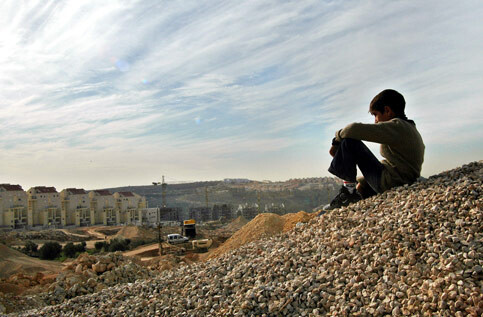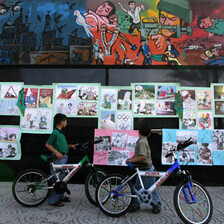
A Palestinian boy from Bilin outside Ramallah sits over an Israeli settlement being constructed next to the village, December 2005. (Charlotte de Bellabre/MaanImages)
A few months ago I was walking in the hills near the West Bank city of Ramallah where I live when I was stopped by an armed Jewish settler from the nearby Israeli settlement of Dolev. He interrogated me as to where I lived, what I was doing in the Ramallah hills and insisted on seeing my identification documents. When I gathered the courage to ask him who he was and what he was doing there, he answered:
“Unlike you I live here.” Then added: “I really live here.”
Ever since I heard these words from the settler I have wondered what his implied challenge meant. He had that glint in his eye as if he knew something that I did not. What could it be? It was a few months later that I found out.
After stopping me the settler dialed the Israeli army by punching their number on his mobile phone. He seemed very friendly with them. They were his army and were there to protect him from me. They would respond to his call, not to mine. The hills were off limit to the Palestinian police. Technically, by walking in these hills without a permit from the Israeli military authorities I was breaking the law.
The cocky settler lived in the settlement of Dolev on the hill just above the Palestinian village of Ayn Qenya, a seven-mile drive north of Ramallah. Established in 1979, most of Dolev’s residents seemed to be working at the military headquarters northeast of Ramallah prior to the Oslo Accords. Thus, they had to cross Ramallah to get to and from work and to ensure that they didn’t lose their way the Israeli military drew a yellow line in the middle of the road along the path they needed to follow. In October 1990, as they drove up along that line they shot at the lighted window of our house and just missed my wife. We kept the shrapnel as a momento mori.
During the first Palestinian intifada a resident of Dolev, Yair Mendelson, was killed while driving back to the settlement. It was claimed that a Palestinian had shot at his car which then swerved around a sharp corner and veered into the valley. A short time after that incident, while walking in the area I found that a bulldozer was destroying the centuries-old terracing and uprooting olive trees. I thought it might be widening the road. Later I saw a large boulder on which the words “Yad Yair” were painted in Hebrew and propped up high above the road only two miles north of Ramallah. “Yad” in Hebrew means hand and also goal. A shrine had been constructed on land belonging to residents of Ramallah dedicated to the memory of the Israeli from Dolev. A short while afterwards the army established a post on that spot and a road barrier was constructed that stopped cars and pedestrians as I found out when I tried to cross on foot on my way back from one of my walks down that valley.
This was inevitably followed by the expropriation of hundreds of acres of land reaching all the way up the hill close to the last homes north of Ramallah. The area was then surrounded by barbed wire curtailing the expansion of the town. Shortly afterwards hundreds of acres of land south of that post reaching to the last houses at the outskirts of Ramallah were expropriated by the army and surrounded by barbed wire. Our hills were being prepared for the establishment of yet another Jewish settlement. I had witnessed this process before in other parts of the West Bank.
The period after the Oslo Accords were signed witnessed extensive Israeli settlement building, and the number of Jewish settlers more than doubled. However, successive Israeli governments showed no interest in establishing another Israeli settlement so close to Ramallah in the area of land they had earlier expropriated. It was likely that in a final peace agreement with the Palestinians such isolated settlements like Dolev would have to be evacuated. After Israel began building its “separation wall” in and along the West Bank in 2002, its declared route added to the suspicion of Dolev’s settlers. With money from the United States they were able to establish 12 outposts north of Ramallah, most of which Israel itself deem to be illegal. Yad Yair was going to be another of these and the closest to Ramallah.
I once asked a resident in the village of Ayn Qenya whether settlers pass through the village.
“Yes, every morning, very early. Before sunrise they drive through towards Ramallah. They seem to have a place of worship and they stay there until morning then drive back,” he replied.
I wondered about this. I had been relieved that our hills were spared more settlement because there was no mention of Ramallah in the Bible and so a claim for possession based on religious grounds as was the case in Jerusalem and Hebron would not be possible. Could I have been wrong?
It was only when journalists reported in mid-September on the Israeli army’s battles with settlers at Yad Yair that I learned about the synagogue established there named after Yair Mendelson. It was then that I recalled that a much-visited shrine had been constructed near Hebron at the grave of Baruch Goldstein, who had murdered 29 Palestinian worshipers and wounded 125 at the Ibrahimi Mosque on 25 February 1994.
I was relieved by the decisive action of the army on 18 September in bulldozing this fledgling settlement, illegal under existing Israel law, as well as international law. But the settlers have promised to return and the Israeli army, so effective in laying siege to Palestinians, is often willing to compromise with the settlers.
For the past decade and a half, as I stood at the roof of my house in the morning enjoying the sunrise over the Ramallah hills, a few meters down the hill the Jewish settlers were watching the sun rise over the same hills and planning their next move to make them their own. My only hope that this latest threat to my future in Palestine would be thwarted arises from the financial crisis in the US. Without American funding from public and private sources, the hugely expensive settlement project in our hills would not have been possible in the first place. Better still without the damaging interference of groups of religious fanatics from abroad, Christian and Jewish, using their financial muscle to pervert the peace, the two nations, Israeli and Palestinian, living in the same territory may yet find a way to live together.
Raja Shehadeh is the author of Palestinian Walks, Forays into a Vanishing Landscape which won the Orwell Prize for Political Writing.




